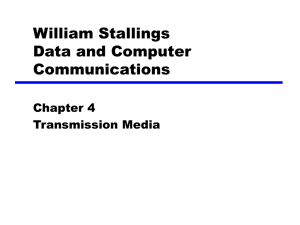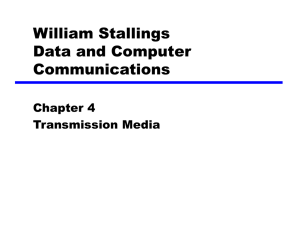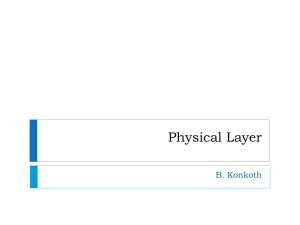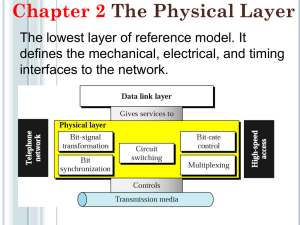Transmission Media After this lecture, you will be able to –
advertisement
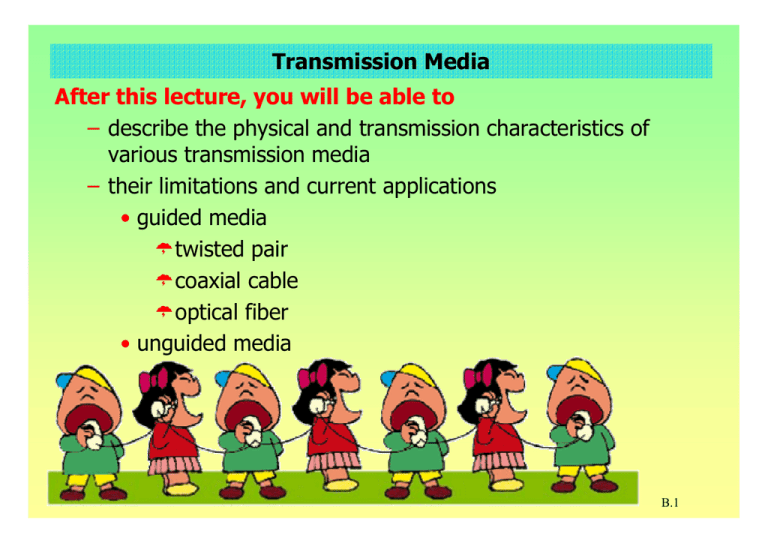
Transmission Media After this lecture, you will be able to – describe the physical and transmission characteristics of various transmission media – their limitations and current applications • guided media ¾twisted pair ¾coaxial cable ¾optical fiber • unguided media B.1 References – Chapter 3 W. Stallings, Data and Computer Communications B.2 Introduction Transmission media – physical path between transmitter and receiver • Examples ¾the path between the satellite and the ground station in satellite communication systems ¾the path between two computers ¾ B.3 Introduction: Guided and Unguided Two categories – guided media • guided along a solid media • Example ¾twisted pair, copper coaxial cable, and optical fiber. – unguided media • atmosphere and outer space • Example ¾wireless broadcast channels, mobile radio channels, and satellite channels B.4 Introduction: their effects – The quality of transmission is determined by both the characteristics of the medium and the characteristics of the signal. • For guided media, the medium itself is more important in determining the limitations of transmission • For unguided media, the bandwidth of the signal is more important than the medium because the medium is shared by many applications B.5 Introduction: operating frequencies B.6 Guided Medium Basic characteristics – point-to-point transmission characteristics Transmission medium total data rate Repeater Spacing -----------------------------------------------------------Twisted pair 4 Mbps 2 - 10 km Coaxial cable 500 Mbps 1 - 10 km Optical fiber 2 Gbps 10 - 100km B.7 Twisted pair – Least-expensive and most widely used Physical description – consists of two insulated copper wires arranged in a regular spiral pattern – a number of these pairs are bundled together into a cable – twisting tends to decrease the crosstalk interference between adjacent pairs in a cable – Neighboring pairs in a bundle typically have different twist lengths to reduce the crosstalk interference B.8 Twisted pair : applications Applications – telephone network • connects individual residential telephone sets to the local telephone exchange ¾These are referred to as subscriber loops B.9 Twisted pair : applications Applications – communications within buildings • connects telephone sets to the in-house private branch exchange (PBX) system PBX Local Telephone exchange – These installations (telephone network and PBX system) were designed to support voice traffic but can handle digital data traffic by means of a modem B.10 Twisted pair : applications Applications – Twisted pairs is also the most common medium for digital signaling. • Digital PBX within a building • local area networks ¾data rate up of 100 Mbps – long distance applications • data rates of 4 Mbps or more B.11 Twisted pair: transmission characteristics Transmission characteristics – the attenuation for twisted pair is a very strong function of frequency – susceptible to interference and noise because of its easy coupling with electromagnetic fields • Example ¾a wire run parallel to an ac power line will pick up 60Hz energy – Therefore, • twisted pair is limited in distance, bandwidth, and data rate B.12 Twisted pair: transmission characteristics B.13 Unshielded and Shielded Twisted pair Unshielded twisted pair (UTP) – ordinary telephone wire – commonly used for local area networks – subject to external electromagnetic interference shielded twisted pair (STP) – twisted pair shielded with a metallic braid – more expensive B.14 Twisted pair Categories of UTP – category 3 • UTP cables and associated connecting hardware whose transmission characteristics are specified up to 16 MHz • corresponds to the voice-grade cable found in abundance in most office buildings • Data rate up to 16 Mbps – category 4 • specified up to 20 MHz B.15 Twisted pair – Category 5 • specified up to 100 MHz • Category 5 is a data-grade cable • Data rate up to 100 Mbps – A key difference between Category 3 and Category 5 cable is the twist length B.16 Coaxial Cable Physical description – a hollow outer cylindrical conductor that surrounds a single inner wire conductor – inner conductor is held in place by either regularly spaced insulating rings or a solid dielectric material – The outer conductor is covered with a plastic covering B.17 Coaxial Cable Applications – television distribution • cable TV system can carry dozens or even hundreds of TV channels at ranges up to a few tens of miles – long-distance telephone transmission • using frequency-division multiplexing (FDM), a coaxial cable can carry over 10000 voice channels simultaneously – local area networks B.18 Coaxial Cable Transmission characteristics – transmit both analog and digital signals – Because of its shielded, concentric construction, coaxial cable is much less susceptible to interference and crosstalk than twisted pair – The principle constraints on performance are attenuation, thermal noise, and intermodulation noise B.19 Optical Fiber Physical description – thin (2 to 125 µm), flexible medium capable of conducting an optical ray – made of various glasses and plastics • Ultrapure fused silica ¾lowest attenuation ¾difficult to manufacture • Glass fiber ¾higher loss ¾more economical • Plastic fiber ¾even less costly ¾used for short-haul link B.20 Optical Fiber – core: inner-most section – cladding: surrounding the core – jacket: outermost layer, surrounding one or a bundle of cladded fibers B.21 Optical Fiber Applications – long-haul trunks • increasingly common in the telephone network • routes average about 900 miles in length • high capacity ¾typically 20000 to 60000 voice channels – metropolitan trunks • joining telephone exchanges in a metropolitan or city area • average length of 7.8 miles • as many as 100000 voice channels B.22 Optical Fiber – rural-exchange trunks • link towns and villages • circuit lengths ranging from 25 to 100 miles • most have fewer than 5000 voice channels – local area networks • total capacity of 100 Mbps – subscriber loops • fibers run directly from the central exchange to a subscriber • telephone networks evolve into full-service networks capable of handling not only voice and data, but also image and video B.23 Optical Fiber Advantages – greater capacity • frequency band for optical communications ~ 1014 1015Hz. If the bandwidth is 0.1% of the optical frequency, bandwidth is 100 - 1000 GHz. – smaller size and lighter weight • Optical fiber is significantly smaller and lighter than electrical cables. A large coaxial cable system can involve a cable of 10-20cm in diameter. A fibre cable could be less than 1cm in diameter. B.24 Optical Fiber – lower attenuation B.25 Optical Fiber – electromagnetic isolation • Because the connection is not electrical, you can neither pick up or create electrical interference. This is one reason that optical communication has so few errors. • In a building this means that optical fiber can be placed almost anywhere electrical cables would have problems, (for example near a lift motor or in a cable duct with heavy power cables). B.26 Optical Fiber – Signal security • The light from optical fibers does not radiate significantly and therefore they provide a high degree of signal security. • In fact, it is possible to tap optical fiber. But it is difficult to do and the additional loss caused by the tap is relatively easy to detect. There is an interruption to service while the tap is inserted and this can alert operational staff to the situation. B.27 Optical Fiber Transmission characteristics – operate in the range of 1014 to 1015 Hz • infrared and visible spectra – light from a source enters the cylindrical glass or plastic core – rays at shallow angles are reflected and propagated along the fiber; other rays are absorbed by the surrounding material B.28 Optical Fiber Attenuation – Impurities in the glass can absorb light but the glass itself does not absorb light – Variations in the uniformity of the glass cause scattering of light – Both the rate of light absorption and the amount of scattering are dependent on the wavelength of the light and the characteristics of the particular glass. Most light loss in a modern fiber is caused by scattering. B.29 Optical Fiber Attenuation B.30 Optical Fiber Attenuation – Short wavelength band (800-900nm): used in 70s and early 80s. – Medium wavelength band (1310nm): the band in which the majority of long distance communications systems operate today. – Long wavelength band (1500-1600nm): All new communication systems use this band. B.31 Optical Fiber Attenuation (/km) B.32 Optical Fiber – Multimode step-index – Multimode graded-index – Single-mode B.33 Optical Fiber Multimode fiber – Inside a multimode fiber, there is a finite number of possible paths for the light to take. These paths are called modes. – The number of possible paths depends on the diameter of the core. • Example, ¾For a fiber with a core diameter of 62.5nm using light of wavelength 1300nm, the number of modes is around 400. – The problem with multimode operation is that some of the paths taken by particular modes are longer than other paths. This means that light will arrive at different times. Therefore the pulse tends to disperse as it travel through the fiber. B.34 Optical Fiber – To reduce the time difference in different paths, the refractive index of the core changes gradually from the center to the edges. – Light travel down the center of the fiber experiences a higher refractive index than light travels further out towards the cladding • (Note: the refractive index is defined as the ratio of the speed of light in vacuum over the speed of light in a medium) B.35 Optical Fiber Single-mode fiber – If the fiber core is very narrow compared to the wavelength of the light in use then the light cannot travel in different modes and thus the fiber is call “single-mode”. • The core diameter is typically between 8 and 9µm B.36 Optical Fiber Light sources – light-emitting diode (LED) • less costly • operates over a greater temperature range • longer operational life – injection laser diode (ILD) • more efficient • can sustain greater data rates B.37
